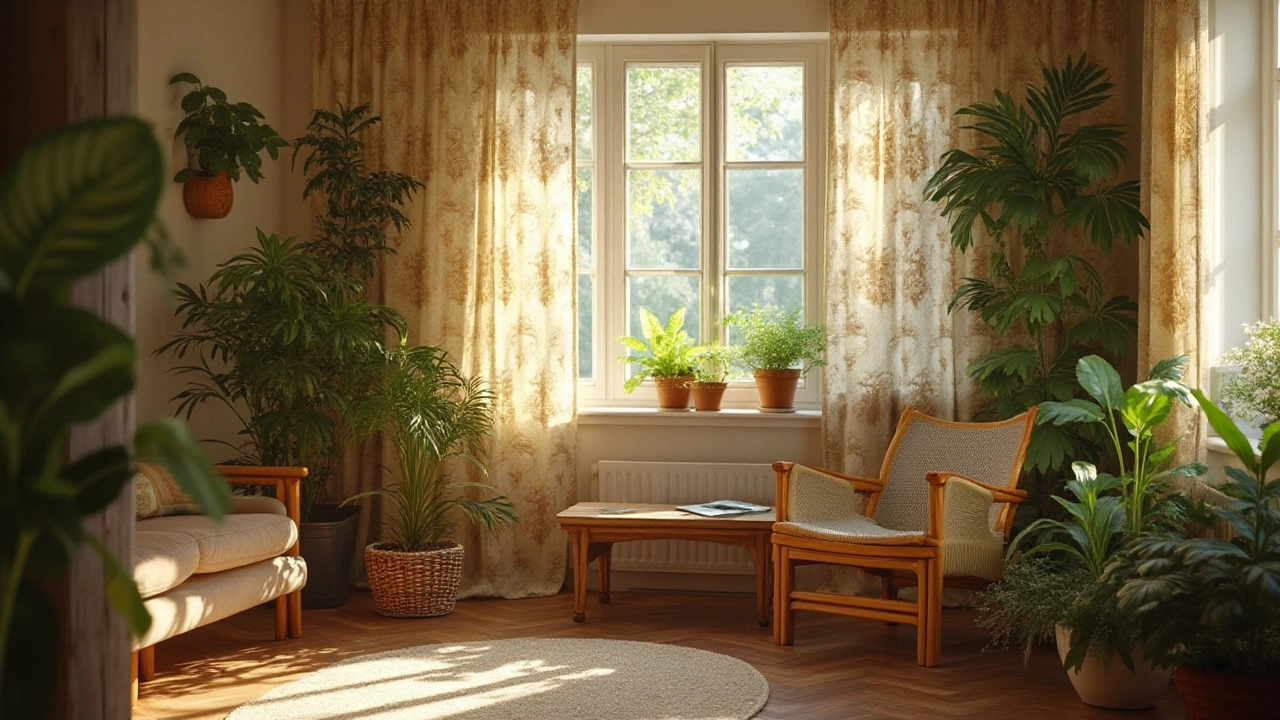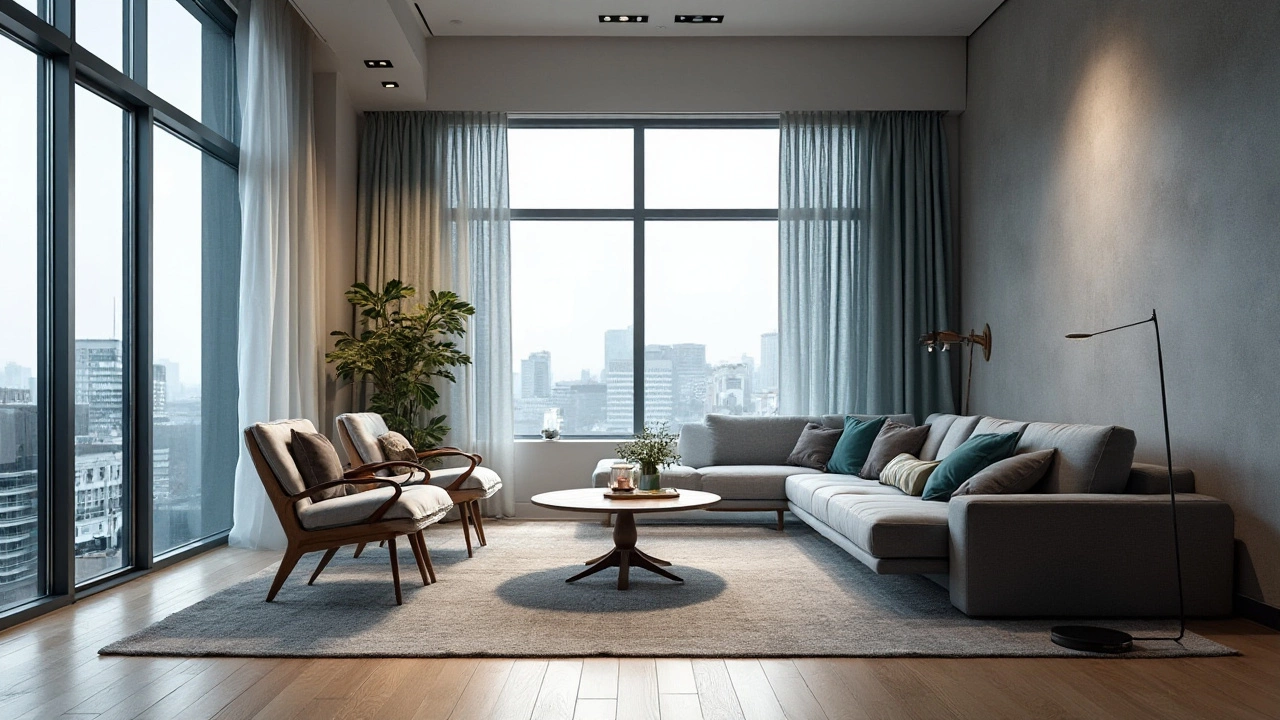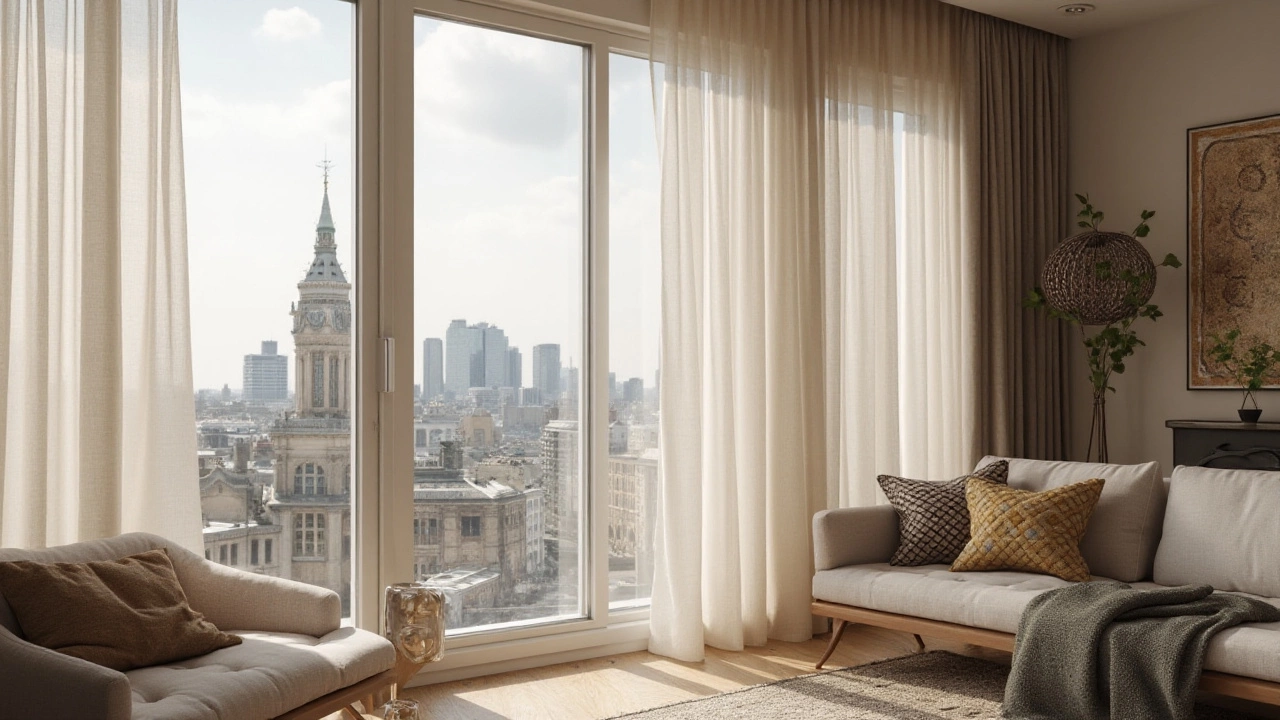As we step into 2025, curtain trends are not just about covering windows – they are a portal into the heart of interior design. This year reveals a fascinating blend of innovation and style. Homes are transforming into expressions of individuality, comfort, and even technology, through the humble yet mighty curtain.
This season, environmentally conscientious choices are more essential than ever, with curtain manufacturers embracing sustainable fabrics like organic cotton and recycled materials. The rise of smart curtains is integrating technology into everyday life, making it possible to adjust lighting and enhance privacy with a simple tap of a smartphone.
Sustainable Materials
The curtain industry is embracing a green revolution, as more and more manufacturers recognize the need for environmentally friendly practices. One of the most significant curtain trends of 2025 is the growing demand for sustainable materials, which cater to an audience that is becoming increasingly eco-conscious. This shift is not just about reducing the carbon footprint, but also about crafting beautiful, durable pieces that don’t compromise on style. Curtains made from natural fibers like organic cotton, hemp, and linen are gaining popularity, offering an aesthetic that feels grounded and authentic. These materials not only decompose naturally, reducing landfill waste, but they also bring a natural elegance into the home, which synthetic fabrics often fail to replicate.
As people strive to make greener choices, recycled materials are also entering the spotlight. Fabrics derived from post-consumer waste, such as recycled polyester, are being celebrated for their ability to transform something old into something new and functional. This alignment of style with sustainability makes recycled curtains an appealing choice for many homeowners looking to revamp their interior spaces without harming the planet. Companies are also getting creative by weaving in older, discarded threads to produce unique, multi-tonal fabric designs that tell a story. These innovations are proving that responsible choices can be chic and desirable.
Beyond the materials themselves, process improvements in curtain production are contributing to a more sustainable approach. Using water-based dyes and low-impact dyeing methods reduces water consumption and minimizes the production of toxic byproducts. Brands are also moving towards zero-waste production techniques, ensuring that every scrap of fabric is utilized within new creations, leaving nothing to waste. This holistic approach to production is becoming a benchmark for modern curtain design, pushing the industry forward in environmental responsibility.
"We believe in creating home environments that people can feel good about," says a spokesperson from a leading sustainable curtain brand. "Our commitment to sustainable practices is not just a trend, but a promise for a healthier planet."
The cost of these eco-friendly materials might be higher, but the long-term benefits are priceless. Longevity, reduced environmental impact, and knowing that every curtain purchase contributes positively towards sustainable living is more important than ever before. These current trends are transforming the way interior space is perceived and appreciated. As the demand for sustainable home decor rises, so will the innovation surrounding eco-friendly materials, hopefully paving the way for a future where sustainability is not an option, but the standard. Opting for sustainable curtain materials is just one of the many steps in enhancing both your living space and the world around us.
Smart Curtains: Technology Meets Elegance
The wonderful world of smart curtains has taken the realm of window treatments by storm, turning them into marvels of modern technology. Imagine waking up, and with the gentle nudge of dawn, your living space bathes in the soft light of morning sun as your curtains slide open automatically. This innovation is not just a dream but a reality that's at the fingertips of many households today. These curtains can be controlled effortlessly via apps on smartphones or through voice commands using systems like Amazon Alexa or Google Assistant. The integration of smart technologies not only enhances convenience but also promotes energy efficiency by regulating natural light, reducing the dependence on artificial lighting, and helping maintain optimal room temperatures.
The installation and operation of smart curtains are simpler than one might anticipate. With the rapidly advancing field of home automation, these curtains can synchronously work alongside other smart devices creating a cohesive smart home environment. It's intriguing how these seemingly simple functionalities can dramatically alter the ambiance of a home and elevate its aesthetic appeal. This elegance comes with various customizations; from setting schedules for when curtains open and close, to integrating sensors that react to the changing external light conditions. Such customization offers an additional layer of privacy and convenience which appeals to tech-savvy homeowners who desire a seamless living experience.
According to a report from Business Insider's Intelligence Unit, the smart home market is expected to grow significantly in the coming years, with smart curtains likely playing a robust role as a popular choice for window treatment upgrades. This statistic is a clear indication of the growing interest in integrating technology with home decor. A user-friendly interface coupled with compatibility with a range of smart home systems significantly increases the allure of these technologically advanced coverings.
A recent report highlighted by Forbes stated, "Smart home products are increasing in mainstream awareness as they innovate to meet consumer desires for convenience, security, and energy savings." This reflects the evolving consumer preference towards products that bring tangible improvements to daily life.
The emergence of smart curtains is gradually transforming the interior design landscape. By merging aesthetics with technology, these curtains represent a modern approach to home decor that prioritizes both functionality and beauty. They serve not only as a tech-forward statement in a room but also as a practical solution to everyday inconveniences associated with manual curtain operation. A trend to watch in 2025, these advanced window treatments continue to pave the way for inventive ways to integrate technology into personal spaces, promising a future where home environments adapt to the rhythms of modern life.

Minimalist Designs
Minimalism has made a resounding comeback in the realm of curtain trends for 2025. This approach to design centers around simplicity and functionality, stripping away unnecessary elements to let essential beauty shine through. In a world often overflowing with choice, minimalist curtains provide a sense of calm and understated elegance. Neutral colors dominate this trend, with shades of white, cream, gray, and beige offering a backdrop that complements any room’s decor. The beauty of this design lies in its versatility; a minimalist curtain can adapt to nearly any interior style, whether rustic, industrial, or contemporary.
The fabrics used in minimalist designs are often light and airy, allowing natural light to flow gracefully into a space. Linen, sheer cotton, and muslin are popular choices, known for their subtle textures and breathable qualities. Patterns, if any, are subtle and understated, with simple stripes or grid designs adding just enough visual interest without overpowering the room. Clean lines and thoughtful details, like hidden tabs or sleek metal grommets, complete the look, ensuring that the focus remains on the architecture and furniture of the room.
Minimalist designs are not constrained to a particular format or style. The key is in the balance between functionality and aesthetic appeal, which can mean something different for each homeowner. For those living in bright, bustling cities, minimalist curtains help create a peaceful, uncluttered haven that contrasts with the chaos outside. Meanwhile, those in rural settings may appreciate how these designs accentuate their natural surroundings, allowing the beauty of their landscape to peek through.
Jane Doe, an acclaimed interior designer, once said, "Minimalism is not about having less, but about making room for what truly matters." This encapsulates the appeal of minimalist curtains – they make space for genuine beauty and practicality by eliminating excess, focusing instead on what adds real value to a living space.
A minimalist approach doesn't always mean stark or colorless. Many are choosing to emphasize bold patterns in minimalist spaces, as long as they adhere to the principle of less-is-more. A single-tone curtain with a bold geometric print or an abstract motif can be the perfect centerpiece in a room with monochrome furnishings. The result is a harmonious and balanced space that tells a story without needing words.
If you're considering minimalist designs for your curtains, it might be useful to assess your room's needs thoroughly. Do you require more light, or is privacy a priority? Minimalist curtains can be layered too – sheer panels with heavier drapes for a dynamic, tailored window treatment. As minimalist curtains grow in popularity, they underscore a deeper movement towards finding beauty in restraint, which is a timeless and adaptable choice for any home.
Bold Patterns
This year, bold patterns in curtain trends are making waves, adding a splash of vibrancy and daring to the home environment. As part of the broader home decor movement, these patterns are about storytelling and making a statement, where each design can transform a simple room into a conversation piece. Designers are pushing the boundaries with geometric shapes, abstract motifs, and culturally inspired designs that are not just seen but experienced. A living room with curtains featuring a vivid, oversized floral print can instantly take on a fresh and renewed energy, inviting warmth and excitement into the space.
The essence of bold patterns lies in their ability to reflect the personality and style of the homeowner. This year’s trends are all about individuality, with patterns that defy the conventional and venture into the realm of avant-garde. A resurgence of Art Deco influences can be seen in many window treatments, where intricate lines and shapes create a fusion of retro and contemporary that harks back to the roaring twenties with a modern twist. According to the interior magazine, House Beautiful, bold patterns are ‘essentially wearable art for your windows’.
To effectively incorporate bold patterns into a home's interior design, it's crucial to consider other elements within the space. Complementary colors and textures in furniture pieces or wall finishes can tie together a cohesive look. For those who are hesitant to make a significant change, starting with smaller areas such as a reading nook or a breakfast alcove can offer a great canvas for experimentation. Layering different textures such as velvet with a bold patterned curtain can create depth, providing a luxurious and inviting atmosphere. It's like crafting an outfit – balancing statement pieces with classic staples.
Interestingly, psychologists suggest that patterns and colors can significantly impact mood and emotional responses. A room with a bright, dynamic curtain pattern can boost energy levels and foster creativity, making it ideal for spaces used for brainstorming or artistic pursuits. Conversely, opting for a room with less visual complexity might suit areas designed for relaxation. Knowing how these elements affect well-being can be a valuable tool in choosing the right window treatments for each space.
But what should you consider when selecting a pattern that stands out yet harmonizes with your home decor? Here are a few tips: First, evaluate the size of the room. Large patterns work well in bigger spaces, providing a focal point without overwhelming it. Second, consider light. Some patterns become more pronounced with natural light, while others may appear too busy. Finally, don't shy away from patterns with historical or cultural significance – they often bring a unique story and heritage that enriches the living space. Embrace the boldness, and your curtains could soon be the crowning jewel of your home.
"The trend in 2025 is not just about choosing patterns but letting them speak for themselves, enunciating themes of personality and boundary-pushing creativity," said interior design expert, Ava Monroe, during an interview with Better Homes & Gardens.

Biophilic Influences
Biophilic design has increasingly integrated into our living spaces, with the curtain trends of 2025 embodying this harmonious blend of nature and living. Biophilic influences in curtains mean incorporating elements that mimic the experience of the natural world. This year, designs that evoke the serenity of forests, the calm of oceans, and the vibrancy of florals are taking center stage. It's about creating a sanctuary within one's home that resonates with the peace and tranquility of nature. The infusion of plant-based patterns and earth-toned palettes is designed to create a soothing atmosphere, providing a breath of fresh air without leaving your living room. This also plays into the larger trend of people wanting to bring the outdoors inside, a nod to ancient design philosophies that place humans in tune with nature.
The materials chosen often include organic fabrics, which not only contribute to the aesthetic but also promote sustainable living. Curtains made from fibers like jute and bamboo veneering are not only sustainable but add texture and depth, enhancing the room’s connection to the environment. With these influences, the goal is not just about having beautiful drapes but creating an emotional connection to the space. These fabrics often bear intricate leaf patterns, floral prints, or abstract depictions of landscapes, each telling its own unique story. Interior designers recommend using such curtains to frame windows with views of nature, allowing the transition from indoors to outdoors to feel seamless. It turns the home into an ecosystem of visual and sensory delight.
"Biophilic design is more than a trend; it's a shift in living consciousness," said Michael Wong, a renowned interior design expert known for his nature-inspired aesthetics. "Incorporating natural elements through simple choices like curtains can have profound effects on wellbeing and mental health."
There is also a fascinating intersection of technology with biophilic influences. Some innovative curtain designs incorporate materials that adjust based on the light, aiming to mimic natural changes in the environment throughout the day. This subtle shift can help in maintaining our circadian rhythms, ultimately enhancing sleep quality and productivity. The design process often involves studies on how natural light positively impacts human moods and activity levels, encouraging more dynamic use of time at home. Designers are looking to biophilic curtain trends to create these experiences, curating spaces that speak to humans' inherent love for nature and the serenity it offers.
Recently compiled data from the Home Decor Institute suggest that 67% of homeowners have expressed a desire for more natural elements in their interiors, with curtains being a primary target for these updates. This transformation not only improves the aesthetic appeal of a home but also contributes significantly to environmental sustainability efforts. Biophilic curtains have shown to reduce energy consumption by enhancing interior climate control through natural shading, showcasing that design can triumph effectively when aligned with environmental goals. There is a growing appreciation for these kinds of innovations as society places greater emphasis on ecological mindfulness when renovating living spaces.
